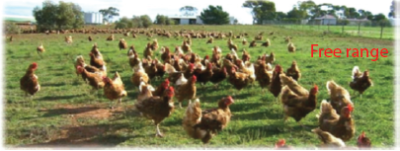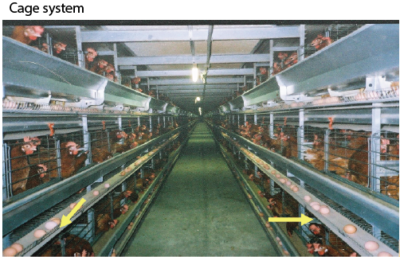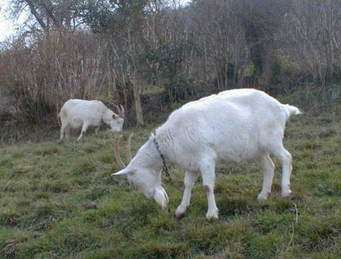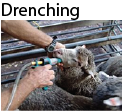
Animal-husbandry-upper primary science

Domestic animals
The animals that are kept at home are called domestic animals. Domestic animals include pets and livestock. Pets include cats, dogs and pigeons.
Livestock
Livestock or farm animals are kept for their products. Livestock can be classified according to the products they offer. Livestock can be classified as:
Poultry
These are domestic animals that are kept for eggs and meat. Examples of poultry are chicken, ducks, turkeys and geese. Chickens can be classified as either layers or broilers. Layers are the chicken kept for eggs. Broilers are kept for meat.
The table below shows poultry products
| Animal type | Product |
| chicken (layers) | eggs |
| chicken (broilers) | meat |
| ducks | eggs and meat |
| turkey | eggs and meat |
| geese eggs and meat | |
Systems of rearing poultry
Free range system
- Oldest system and adopted only when adequate land is available
- Rearing of poultry by letting them loose on ground (Field) called as range
- A range should provide shelter, greens, feed, water, shade etc
- Foraging is major source of feeding for birds Ø Shelter is usually provided by temporary roofing supported by ordinary poles

Advantage of free range system
It is cheap
Disadvantage
- It is easy for diseases to spread
- Poultry may be eaten by animal
- Poultry can easily be stollen
Deep Litter System
- Poultry birds are kept in large pens on floor, mainly for broilers
- Floor is covered with litters , such as straw, saw dust or leaves up to depth of 2-3 inches
- Bird density: 5-7 birds per square meter

Advantages
Birds have easy access to feeds and water
Easy collection of eggs
Provides good protection to bird
Immunization and treatment easily provided.
Disadvantages
It is expensive to begin
Easy spread of diseases
Cage system
- Rearing of poultry on raised wire netting floor in smaller compartments, called cages. Cages of 1 to 10 birds may be constructed
- Initially introduce for individual egg & pedigree recording & culling of poor layers
- At present, 75% of commercial layers in the world are kept in cages

Advantages
- Suitable for keeping high density of birds, when space is limitation
- Scientific management practices can be followed
- Feeders and waterers are attached to cages from outside, except nipple waterers, for which pipeline is installed through or above cages
- Auto-operated feeding trolleys and egg collection belts can also be used
- The droppings are either collected in trays underneath cages, on belts or on floor or deep pit under the cages
Disadvantages
It is expensive to construct.
Bird habits
- fighting
- feather pecking
- egg eating
Preventing egg eating habit
Egg breakage is one of the main reasons hens begin eating eggs. Reducing or eliminating egg breakage minimizes the chances your hens will get a taste for raw egg.
- Avoid bright lighting near the nesting boxes.
- Don’t disturb hens in the nests.
- Make sure you have enough space for each hen in the coop.
- Keep fresh feed and water available at all times.
- Set up a second feeding station if one hen is bullying the others by guarding a single feeding station.
- If possible, provide hens with space outdoors to roam or at least a run with fresh grass and bugs.
- Beak cutting
Cattle
These are livestock that are either kept for meat or for milk. Cattle include cows and bulls. Cattle can be grouped into;
- Beef cattle, which are kept for meat for example, Boran, Hereford, Sahiwal, and Redpoll.
- Dairy cattle, which are kept for milk. Examples of dairy cattle include the Fresian, Guernsey, Ayrs
Sheep
These are domestic animals that are kept for their meat and their wool.
The meat of sheep is called mutton. The wool is shaved and made into clothes.
Examples of sheep are Merino (kept for mutton and wool) and Dorper (kept for mutton).
Goats
Goats are livestock that are kept for their meat and for milk. Examples of goats are Toggenberg (kept for milk and meat) and the East African goat {kept for meat).
Care of animals
All the domestic animals need to be taken care of in various ways. Livestock can be taken care of in the following ways:
- Providing shelter
- Feeding them
- Giving them water
- Giving them medical care to get rid of livestock diseases
- Protecting diem against parasites and predators
Providing shelter for livestock
Buildings and constructions in a farm are called farm structures. The buildings include animal houses and animal sheds while constructions include fences and crushes. All the buildings and constructions are necessary if we have to care for livestock properly.
What factors do we consider when constructing farm structures?
- Drainage – the structure must be constructed at a place with good drainage to ensure that the animal structure is always dry and that no livestock parasite can breed around.
- Security – the animal structure should be appropriately close to the farm-house so that the farmer can keep an eye on the animals to be able to protect them from thieves or wild
- Noise – the animal structure needs to be located at the place with least
Poultry for instance get stressed if there is too much noise. This reduces their rate of laying eggs. - Water-water and other facilities like adequate lighting and warmth should be available.
- Wind direction the structure should be shaded from direct wind. They should also not be erected where bad smells from the animal stalls blow away from the farmhouse.
- Some animals for example poultry require the floor to be covered with litter for example wood shavings.
The intention is to keep the floor of the animal structure dry and warm so that they don’t get sick.
All animals need housing to protect them from rain, sun, and other things that may harm them. The animal house should be well maintained and repaired every time they are not intact. The animal house should be cleaned to keep away disease-causing germs and pests. The houses should also be dusted with insecticide and pesticide.
Feeding Livestock
Animal feed are classified into four main groups
- Pasture
These are animal feeds that are grazed directly in the field by animals
They are classified into grasses and legume
- Legume: these provide animals with proteins e.g. glycerine, lucerine, clover and desmodium
- Grasses: they mainly provide animals with carbohydrates g. Rhodes grass, guinea grass
- Fodder crops
These are crops grown for the purpose of feeding animals.
Food crops are cut and taken to the animals, e.g. sweet potato vines, maize stalk, sunflower heads, kale and oats.
- Commercial feeds
They are also called concentrates. They are made in factories and sold in special shop known as agrowers. They contain high nutrient value per units
They carry specific nutrients.
The concentrates are further subdivided into:
(i) Energy or carbohydrates concentrates, which are rich in carbohydrates. Examples are molasses and cereal grains such as maize meal, which come from plants. Groundnuts or cotton-seeds may be consumed as fat concentrates since they provide energy from the oils they produce.
(ii) Protein concentrates, which are rich in proteins such as fishmeal, blood meal, skimmed milk, all of which are from animals, while cotton-seed cake, groundnut cake and soya beans are protein concentrates from plants. Legume seeds for example peas and beans are also protein concentrates.
- Conserved feed
These are animal feeds that are harvested in plenty and stored for future use
They can be stored or preserved while green or dried. They include hay and salige
Balanced diet
Just like human beings, livestock need a balanced diet to provide the nutrients needed to stay healthy and to produce products such as meat and milk of better quality. The nutrients needed are shown in the table below
| Constituent | Why it is needed | Feeds containing the nutrient |
| Protein | Body growth and repair To make good quality products such as milk, eggs and meat | Protein concentrates, mixed pastures, lucerne grass, legumes, layer’s mash / broiler’s mash / chick mash, weaner meal, wheat bran, dairy meal |
| Carbohydrates | Energy production.
To make good quality products such as milk, meat, eggs, wool |
Sweet potato vines, maize stalks, crushed maize cobs, napier grass, wheat bran, layer’s mash/ broiler’s mash/chick mash, rabbit pellets, molasses, weaner meal, sow meal |
| Fats and oils | Energy production Formation of some parts of the body | Natural pastures, energy concentrates such as groundnuts, fish meal |
| Minerals and vitamins | Formation of bones and teeth. Body growth Resistance to diseases | Salt licks, concentrates, kales, sweet potato vines |
| Facilitates the roughages | Ease of digestion. Passing of the faeces easily | Natural pasture, fodder crops, napier meal, wheat bran |
| Water (clean) | To transport things in the body for good digestion The body cannot function without water | Direct intake of water, fresh fruits and vegetables |
Animals need water in adequate amounts. The water must be clean and the containers in which water is put should be clean.
Animals that are not fed on a balanced diet may have the following characteristics:
- Animals look emaciated, they are thin and weak. The young animals are stunted growth.
- The animals have very weak or poor resistance to diseases or infections,
- The bones of the animals are soft, poorly formed, show signs of rickets and can break easily in case of
- The yield of the animal products like eggs, milk or wool, drops consistently
The animals may finally die of malnutrition if the situation persists for long.
Animal feeds can be grouped into concentrates, roughage, supplements, additives and animal products.
Methods of grazing
Grazing is the direct use of pastures by livestock.
The method of grazing animals are classified as
- Rotational method of grazing
- Zero grazing or stall feeding
- Herding
Herding
In this type of grazing, the farmer guides the animals to where good pasture and water sources are available. The animals get good attention and care. The work is tiresome for the herder as he has to go with the animals to where the pasture is and waits till the animals have fed, then take the animals to a source of water before finally taking them back home.
Advantages
- No huge expenses for fencing or water supply.
- One herdsperson can look after hundreds of animals. The labour cost is reduced.
- Animals are free to move about so they have plenty of exercise.
- The farmer doesn’t have to own a lot of land. Pasture can be rented for use for an agreed period.
- Animals get to eat a variety of natural
- Animals are not stressed because they experience a natural environment.
Disadvantages
- Diseases are easily spread among the animals in a herd because they are always close together.
- Animals may mix with other herds, which may cause spread of diseases.
- The animals may sometimes be very far from veterinary services.
- The herdsperson has to travel over long distances. This can be very tiring.
- The herd uses a lot of energy for movement, so there is reduced production of milk.
- The animals cannot be controlled at all times so they may trample on and spoil the pasture.
Zero grazing
Zero grazing is also called stall-feeding. The animals are kept in house called a stall. The farmer harvests the pasture or fodder and takes it to the animals. It is very popular in keeping dairy cows for milk. It is common in areas where land is small.
Advantages
- Livestock cannot get disease easily since their movement is restricted.
- The feeds are used to the maximum.
- Many animals can be fed on a very small area.
- Manure is easily collected since it is in one place.
- Animals can be observed from close
- The animals are more productive.
Disadvantages
- Diseases can easily spread to animals in the same enclosure because stalls might be too close.
- It is expensive to start because stalls have to be built.
- Requires a lot of labor, especially in planting, caring, harvesting and transporting feeds.
- Due to limited movement, animals do not have the chance to exercise.
Rotational grazing
Here the animal graze in pastures which are divided into portions. The animal graze in each portion at a time.
- Tethering
An animal is tied or tethered to a post, a peg or a tree.

Advantages
- Requires less labor
- Expensive fencing is not necessary
- Very good use of pasture because grazing is carefully controlled.
Disadvantages
The animal can choke on the ropes if poorly tethered
- Strip grazing – Animals are kept on strips of land. The fence is moved once the animals have eaten all the pasture on the strip of land.
Advantages
- Maximum use of pasture can be achieved.
- There is no need to spend money on expensive fences.
- Excess pasture can be harvested and stored.
Disadvantages
You need to have very high quality and well maintained pasture so that animals have most nutrients,
- Padlocking or paddock grazing -Animals are kept within a fenced area called a paddock.
Advantages
- Allows for harvesting and storage of pasture.
- Requires a small piece of land.
Disadvantages
- It is expensive to establish the paddocks and supply water.
- Can only be done with a few animals.
Livestock parasites
A parasite in an organism that feeds on another.
External parasites include ticks, fleas and mites
Internal parasites include worms (tape worm and round worm)
What effects do external parasites have on livestock?
- They cause irritation on the animal and make them irritable and uncomfortable.
- The animals may eventually die from the diseases transmitted by parasites.
- They suck blood from the animal and make them suffer from anaemia.
- They transmit diseases to the animals.
- They damage the skin or hide making them to have low value and so the farmers lose on profit.
How can external parasites in livestock be controlled?
- Dipping or spraying the animals with acaricide.
- Hand picking the ticks from the animals and destroying them by burning.
- Hard-dressing the animals with some medicine on the skin.
- Applying some powder medicine inside the animal house to kill the parasites.
- Practicing rotational grazing denies the parasite a host when the livestock is moved to a different area.
- Deworming
Deworming is the administering of medicine orally to live stock in order to control internal parasites
- Drenching involves administering liquid medicine to livestock using a drenching gun

- Dosing involves administering solid medicines in form of tablets to livestock using a dosing or bolus gun.
Livestock diseases
Disease is a condition of the body that is different from the normal condition of the body. When an animal is diseased, then we say it experiences the effect of disease which is called illness or sickness.
What causes diseases in livestock?
There are many things that may cause illness in livestock:
Living organisms are the major cause of livestock diseases. Such living things or disease germs include bacteria, fungi, virus and protozoa.
Lack of certain nutrients in the food.
Food poisoning which includes eating rotten feeds, chemicals, plastic materials, or some animals such as toads (which may be taken in the water the animals drinks).
Effects of livestock diseases
These may be:
- Reduced quality of products e.g. poor hide and skin.
- Lowered or reduced yield or product.
- Transmission of disease to humans such as tuberculosis from infected milk or brucellosis.
- Death of infected animal
Common livestock disease and their symptoms
| Disease | Causative organism | Animal affected | Symptoms |
| Anthrax | Baceria | Camel, sheep, cattle, goats | – Sudden death of animals.
– Un clotted blood-stained discharges through the mouth, nose and anus
|
| Food and mouth disease | Camel, sheep, cattle, goats, pig | 
Lameness in a number of animals Salivaton (drooling) Smacking of the lips, grinding of the teeth Vesiscles/lesions in the mouth (on the tongue, gum, cheeks, lips) Unmillingness to move or stand |
|
| Newcastle
disease |
virus | bird | – Nervous signs such as loss of balance, circulation, head tremor, wing and leg paralysis
– Coughing – Diarrhea
|
| Lumpy skin
disease |
Virus | cattle | 
– Appearance of painful cutaneous nodules in the body, especially the head and neck, genetalia and udder. – Lesion develop in nostril and in the mouth – All the superficial lymph nodes are enlarged |
| Fowl pox | virus | chicken | wart-like skin lesions that progress to thick scabs
|
| Coccidiosis | protozoa | Chicken, rabbit | loss of appetite, weight loss or decreased weight gain, diarrhea (which can be bloody),
dehydration and death
|
| Avian influenza | virus | chickens, turkeys | decreased egg production, depression, respiratory signs suggestive of a cold, swelling of the face, possibly some nervous signs and diarrhea |
| Snuffles | bacteria | rabbit | The bacteria can affect the eyes (discharge, redness, squinting) and/or nose (sneezing, discharge), thus giving the disease its name “snuffles.” |
| myxomatosis | virus | Rabbit | swelling and discharge from the eyes, nose and anogenital region. |
| Rinderpest | virus | cattle | fever, oral erosion, diarrhea |
| Mastitis | bacteria | Cattle
Goat sheep |
· The udder such as swelling, heat, hardness, redness, or pain; and
· The milk such as a watery appearance, flakes, clots, or pus.
|
Fro revision questions download PDF
Animals husbandary -Upper primary
Sponsored by The Science Foundation Colleges + 256 753 80 27 09
Compiled by Dr. Bbosa Science +256 778 633 682
Please find free downloadable notes, exams and marking guides of English, primary math, primary SST agriculture, biology, and chemistry from digitalteachers.co.ug website.
Dr. Bbosa Science





i like the site
That’s not true, is it? IPv4 was designed to put all devices on the internet from the start in 1983 It was about 11 years later that address depletion became a problem and NAT’s were invented as a stopgap
Thanks for making this so enjoyable. Electronics
Your content is always worth the read. Sports News
Join top medical colleges through MBBS Direct Admission in Punjab.
Get access to government college cutoff trends with MBBS Cutoff Of Government Medical Colleges in Uttar Pradesh.
Get started in just a few clicks with the Raja Luck App Download.
Sign up with the platform and trigger benefits with the Diu Win Invite Code.
Enhance cloud computing and data management with Server Rental in Bengaluru.
Download and play the most interesting games now with bdg win app.
Discover amazing challenges and real-time gaming on 55 club.
Master the basics of Technology Roadmap Planning to enhance IT operations.
Make the right purchasing decisions with Household Product Reviews that highlight advantages and disadvantages.
I like how basic Onlymp3 Downloader is to use– simply paste the link and get your audio instantly.
The regional insights in this post are invaluable. I ‘d add that Escort Service In Nainital provides knowledgeable buddies familiar with concealed gems.
If you’re a Food Fan, you’ll wish to try every meal they provide.
A memorable journey awaits with Varanasi Tours, especially if you love cultural heritage.